ThisiscontentfromElsevier'sDrugInformation
Somatropin, rh-GH
Learn more about Elsevier's Drug Information today! Get the drug data and decision support you need, including TRUE Daily Updates™ including every day including weekends and holidays.
General Information for use in GH deficiency:
0.1 to 0.2 mg subcutaneously once daily, initially. Increase the dose by 0.1 to 0.2 mg/dose every 1 to 2 months based on clinical response, serum IGF-1 concentrations, and tolerability. Smaller dose increments and longer time intervals may be necessary.[69452]
0.2 to 0.3 mg subcutaneously once daily, initially. Increase the dose by 0.1 to 0.2 mg/dose every 1 to 2 months based on clinical response, serum IGF-1 concentrations, and tolerability.[69452]
0.4 to 0.5 mg subcutaneously once daily, initially. The dose may be higher for persons transitioning from pediatric treatment; in persons transitioning from pediatric to adult care, resume treatment at 50% of the dose used in childhood. Increase the dose by 0.1 to 0.2 mg/dose every 1 to 2 months based on clinical response, serum IGF-1 concentrations, and tolerability.[69452]
0.15 to 0.3 mg (Usual dose: 0.2 mg) subcutaneously once daily, initially; increase the dose by 0.1 to 0.2 mg/dose every 1 to 2 months based on clinical response, serum IGF-1 concentrations, and tolerability. Alternatively, 0.04 mg/kg/week or less subcutaneously in 6 or 7 divided daily doses, initially; increase the dose every 4 to 8 weeks up to 0.08 mg/kg/week based on clinical response, serum IGF-1 concentrations, and tolerability. Persons with obesity are more likely to experience adverse effects when dosed by weight. Consider a lower starting dose and smaller dose increments for older persons.[45045]
0.15 to 0.3 mg (Usual dose: 0.2 mg) subcutaneously once daily, initially; increase the dose by 0.1 to 0.2 mg/dose every 1 to 2 months based on clinical response, serum IGF-1 concentrations, and tolerability. Alternatively, 0.006 mg/kg/dose subcutaneously once daily, initially; increase the dose up to 0.0125 mg/kg/day based on clinical response, serum IGF-1 concentrations, and tolerability. Weight-based dosing is not recommended for persons with obesity as they are more likely to experience adverse effects when dosed by weight. Consider a lower starting dose and smaller dose increments for older persons.[30059]
0.15 to 0.3 mg (Usual dose: 0.2 mg) subcutaneously once daily, initially; increase the dose by 0.1 to 0.2 mg/dose every 1 to 2 months based on clinical response, serum IGF-1 concentrations, and tolerability. Alternatively, 0.004 mg/kg/dose or less subcutaneously once daily, initially; increase the dose after approximately 6 weeks up to 0.016 mg/kg/day based on clinical response, serum IGF-1 concentrations, and tolerability. Persons with obesity are more likely to experience adverse effects when dosed by weight. Consider a lower starting dose and smaller dose increments for older persons.[58095]
0.15 to 0.3 mg (Usual dose: 0.2 mg) subcutaneously once daily, initially; increase the dose by 0.1 to 0.2 mg/dose every 1 to 2 months based on clinical response, serum IGF-1 concentrations, and tolerability. Alternatively, 0.006 mg/kg/dose or less subcutaneously once daily, initially; increase the dose up to 0.0125 mg/kg/day based on clinical response, serum IGF-1 concentrations, and tolerability. Persons with obesity are more likely to experience adverse effects when dosed by weight. Consider a lower starting dose and smaller dose increments for older persons.[49770] [56647]
0.15 to 0.3 mg (Usual dose: 0.2 mg) subcutaneously once daily, initially; increase the dose by 0.1 to 0.2 mg/dose every 1 to 2 months based on clinical response, serum IGF-1 concentrations, and tolerability. Alternatively, 0.006 mg/kg/dose or less subcutaneously once daily, initially; increase the dose up to 0.025 mg/kg/day based on clinical response, serum IGF-1 concentrations, and tolerability. Persons with obesity are more likely to experience adverse effects when dosed by weight. Consider a lower starting dose and smaller dose increments for older persons.[49770] [56647]
0.15 to 0.3 mg (Usual dose: 0.2 mg) subcutaneously once daily, initially; increase the dose by 0.1 to 0.2 mg/dose every 1 to 2 months based on clinical response, serum IGF-1 concentrations, and tolerability. Alternatively, 0.04 mg/kg/week or less subcutaneously in 7 divided daily doses, initially; increase the dose every 4 to 8 weeks up to 0.08 mg/kg/week based on clinical response, serum IGF-1 concentrations, and tolerability. Persons with obesity are more likely to experience adverse effects when dosed by weight. Consider a lower starting dose and smaller dose increments for older persons.[45044]
0.15 to 0.3 mg (Usual dose: 0.2 mg) subcutaneously once daily, initially; increase the dose by 0.1 to 0.2 mg/dose every 1 to 2 months based on clinical response, serum IGF-1 concentrations, and tolerability. Alternatively, 0.005 mg/kg/dose or less subcutaneously once daily, initially; increase the dose after 4 weeks up to 0.01 mg/kg/day based on clinical response, serum IGF-1 concentrations, and tolerability. Persons with obesity are more likely to experience adverse effects when dosed by weight. Consider a lower starting dose and smaller dose increments for older persons.[56649]
0.15 to 0.3 mg (Usual dose: 0.2 mg) subcutaneously once daily, initially; increase the dose by 0.1 to 0.2 mg/dose every 1 to 2 months based on clinical response, serum IGF-1 concentrations, and tolerability. Alternatively, 0.006 mg/kg/dose subcutaneously once daily, initially; increase the dose up to 0.0125 mg/kg/day based on clinical response, serum IGF-1 concentrations, and tolerability. Weight-based dosing is not recommended for persons with obesity as they are more likely to experience adverse effects when dosed by weight. Consider a lower starting dose and smaller dose increments for older persons.[59579]
0.16 to 0.24 mg/kg subcutaneously per week divided into 6 or 7 equal daily injections.
0.18 mg/kg/week (0.54 International Units/kg) subcutaneously or IM divided into equal doses given either on 3 alternate days, 6 times per week, or daily. The maximum replacement dosage is 0.1 mg/kg (0.3 International Units/kg) given 3 times per week. Dosage should be individualized for each patient.
0.024 to 0.034 mg/kg/dose subcutaneously given 6 to 7 times a week. Dosage should be individualized for each patient.[58095]
0.3 mg/kg/week (approximately 0.9 International Units/kg) subcutaneously divided into daily injections is recommended. In pubertal patients, a weekly dosage of up to 0.7 mg/kg divided daily may be used. Dosage should be individualized for each patient.
Initially, 1.5 mg/kg subcutaneously on the same day each month or 0.75 mg/kg twice each month on the same days of each month (e.g., days 1 and 15).
0.16 to 0.24 mg/kg subcutaneously per week divided into 6 or 7 equal daily injections, preferably administered in the evenings.[45044]
0.18 mg/kg/week subcutaneously or IM; the dose can be divided into equal injections administered daily, 3 times/week, or 6 times/week.
0.18 mg/kg to 0.3 mg/kg subcutaneously per week, divided into equal injections given 3, 6, or 7 times per week. Individualize dosage for each patient based on the growth response. If poor growth persists during the first year of treatment, assess compliance and evaluate other causes such as hypothyroidism, under-nutrition, advanced bone age, and antibodies to recombinant human GH.[59579]
0.2 mg subcutaneously once daily, initially. Increase the dose based on insulin-like growth factor 1 concentrations. Usual dose: 0.5 mg/day.[71685]
0.5 mg/m2/dose or 0.009 to 0.015 mg/kg/dose subcutaneously once daily, initially. Increase the dose to 1 mg/m2/dose or 0.035 mg/kg/dose subcutaneously once daily over 3 to 6 months based on insulin-like growth factor 1 concentrations. Base dose on body surface area in children who are overweight or obese.[71685] The FDA approved dosage is 0.24 mg/kg/week subcutaneously in 6 or 7 equally divided doses.[45044] [45045] [58095]
0.5 mg/m2/dose or 0.009 to 0.015 mg/kg/dose subcutaneously once daily, initially. Increase the dose to 1 mg/m2/dose or 0.035 mg/kg/dose subcutaneously once daily over 3 to 6 months based on insulin-like growth factor 1 concentrations.[71685] [71690]
Generally, 0.48 mg/kg subcutaneously per week divided into 6 or 7 equal daily injections for children who have not manifested catch-up growth by age 2. For younger children with a baseline HSDS between -2 and -3, the initial dose is 0.24 mg/kg/week subcutaneously with upwards titration as needed. For children with a baseline HSDS less than -3 or for older/prepubertal children, the recommended initial dose is 0.48 mg/kg/week subcutaneously with a reduction in dosage towards 0.24 mg/kg/week subcutaneously if substantial catch-up growth is seen during the first few years of treatment.
Up to 0.067 mg/kg/day subcutaneously (0.47 mg/kg/week) is recommended. For younger children with a baseline HSDS between -2 and -3, the initial dose is 0.033 mg/kg/day subcutaneously with upwards titration as needed. For children with a baseline HSDS less than -3 or for older/prepubertal children, the recommended initial dose is 0.067 mg/kg/day subcutaneously with a reduction in dosage towards 0.033 mg/kg/day subcutaneously if substantial catch-up growth is seen during the first few years of treatment.
0.48 mg/kg subcutaneously per week divided into 6 or 7 equal daily injections for children who have not manifested catch-up growth by age 2.[45044]
Up to 0.47 mg/kg subcutaneously per week, divided into equal injections given 3, 6, or 7 times per week. For younger children with a baseline HSDS between -2 and -3, the initial dose is 0.033 mg/kg/day subcutaneously with upwards titration as needed. For children with a baseline HSDS less than -3 or for older/prepubertal children, the recommended initial dose is 0.067 mg/kg/day subcutaneously with a gradual reduction in dosage if substantial catch-up growth is seen during the first few years of treatment.[59579]
0.35 mg/kg (approximately 1.05 International Units/kg) subcutaneously per week divided into daily injections (0.05 mg/kg/day). Dosage should be individualized for each patient. Hemodialysis patients should receive their injection at night just prior to going to sleep or at least 3 to 4 hours after hemodialysis to prevent hematoma formation due to the heparin. Chronic cycling peritoneal dialysis patients should receive their injection in the morning after they have completed dialysis. Chronic ambulatory peritoneal dialysis patients should receive the injection in the evening at the time of the overnight exchange. Nutropin may be continued up to the time of renal transplantation. There are insufficient data regarding the benefit of treatment beyond 3 years. No studies have been completed in patients who have received renal transplants and the use of Nutropin in patients with functioning renal allografts is not indicated.
45 to 50 mcg/kg/dose subcutaneously once daily, initially. Adjust dose based on growth response and insulin-like growth factor 1 concentrations. Max: 68 mcg/kg/day.[62669] [71106]
0.33 mg/kg/week subcutaneously in 6 or 7 equally divided doses. Discontinue treatment when epiphyses are fused.[45044] [45045]
Up to 0.375 mg/kg/week subcutaneously in 6 or 7 equally divided doses. Max: 0.054 mg/kg/day. Discontinue treatment when epiphyses are fused.[30059]
Up to 0.47 mg/kg/week subcutaneously in 6 or 7 equally divided doses. Max: 0.067 mg/kg/day. Discontinue treatment when epiphyses are fused.[58095]
Up to 0.375 mg/kg/week subcutaneously in 3 to 7 equally divided doses. Discontinue treatment when epiphyses are fused.[49770] [56647]
Up to 0.375 mg/kg/week subcutaneously in 3, 6, or 7 equally divided doses. Max: 0.054 mg/kg/day. Discontinue treatment when epiphyses are fused.[59579]
0.35 mg/kg subcutaneously per week divided into daily injections.
0.35 mg/kg subcutaneously per week, divided into equal injections given 3, 6, or 7 times per week.[59579]
Up to 0.066 mg/kg/day subcutaneously is recommended. Prior to initiating somatropin, ensure that the patient has short stature. Not all children with Noonan syndrome have short stature. Twenty-four children aged 3 to 14 years of age received doses of 0.033 mg/kg/day subcutaneously or 0.066 mg/kg/day subcutaneously for 2 years; after 2 years, the dose was adjusted based on growth response and continued until final height was achieved. Using the national reference, height gain from baseline increased 1.5 SDS (mean height gain of 9.9 cm in males and 9.1 cm in females at 18 years of age). Using the Noonan reference, height gain from baseline increased 1.6 SDS (mean height gain of 11.5 cm in males and 11 cm in girls at 18 years of age) was noted. During the first 2 years of treatment, height velocity was greater in the group receiving 0.066 mg/kg/day subcutaneously.
Up to 0.47 mg/kg subcutaneously per week divided into equal doses given 6 to 7 times per week. Discontinue treatment with Genotropin, Omnitrope, or Norditropin when epiphyses are fused.[45044] [45045] [58095]
Up to 0.37 mg/kg subcutaneously per week divided into equal doses given 6 to 7 times per week.
Up to 0.3 mg/kg subcutaneously per week divided into equal doses given once daily every day (i.e., 7 times/week).
Up to 0.37 mg/kg subcutaneously per week, divided into equal injections given 3, 6, or 7 times per week.[59579]
Dosage is based on weight; 0.1 mg/kg subcutaneously once daily at bedtime, not to exceed 6 mg/day. For weight more than 55 kg: 6 mg subcutaneously once daily at bedtime. For 45 to 55 kg: 5 mg subcutaneously once daily at bedtime. For 35 to 45 kg: 4 mg subcutaneously once daily at bedtime. If less than 35 kg: 0.1 mg/kg subcutaneously once daily at bedtime.[33527]
The manufacturer reports use in pediatric patients in 2 small studies; a total of 11 children with HIV associated failure to thrive were treated. In one study, a dose of 0.04 mg/kg/day subcutaneously for 26 weeks was used in 5 children (6 to 17 years). A second study used a dose of 0.07 mg/kg/day subcutaneously for 4 weeks in 6 children (8 to 14 years). Treatment was reported to be well tolerated and consistent with safety observations in growth hormone treated adults with AIDS wasting.[33527]
Specific guidelines for dosage adjustments in hepatic impairment are not available; it appears that no dosage adjustments are needed.
Specific guidelines for dosage adjustments in renal impairment are not available; it appears that no dosage adjustments are needed.
† Off-label indication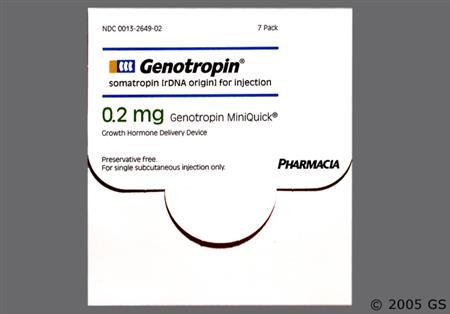
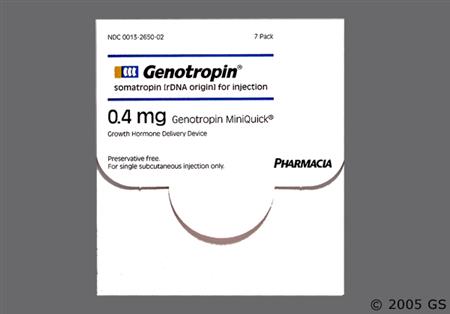
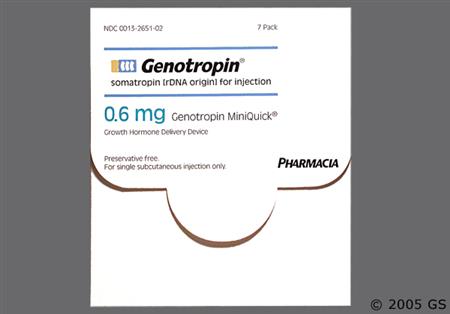


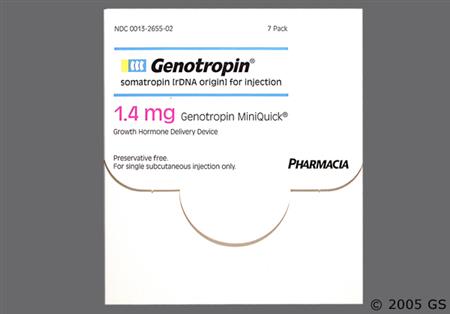
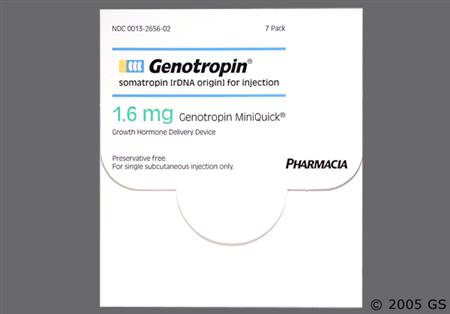
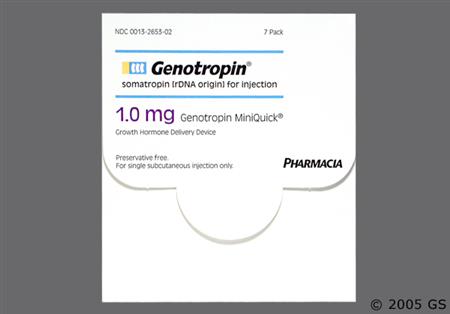
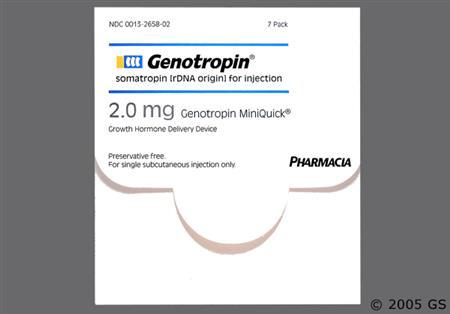
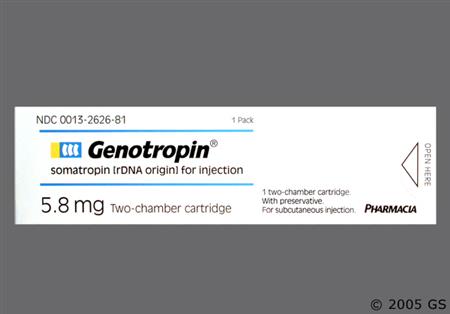
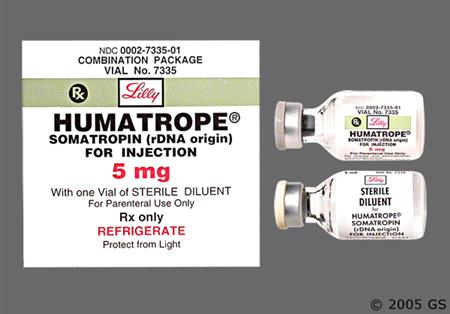

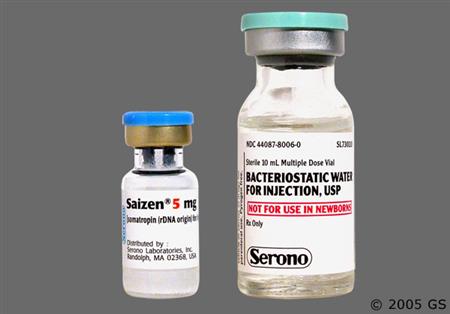
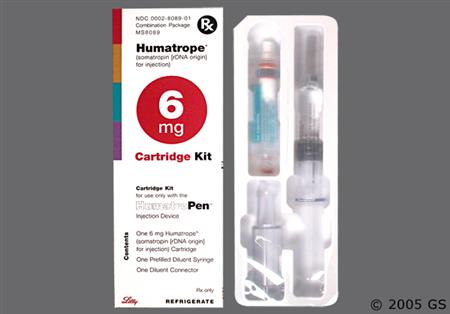
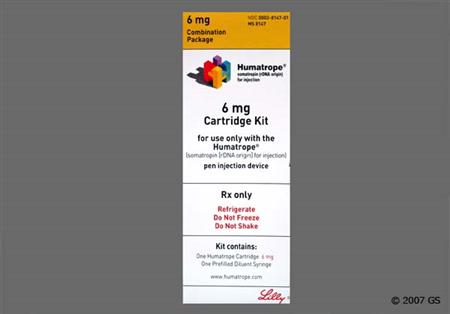
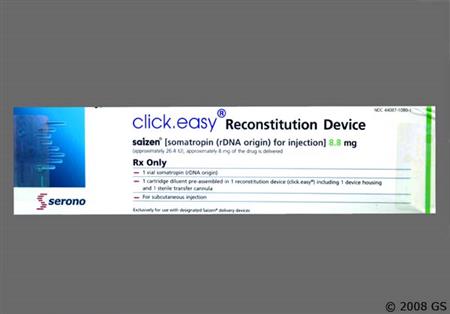
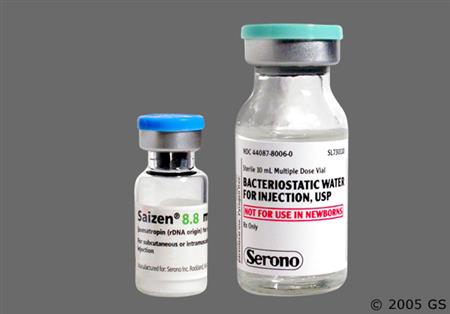
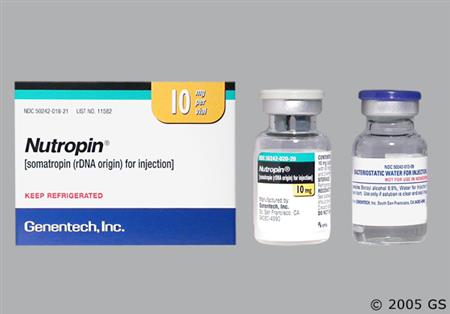
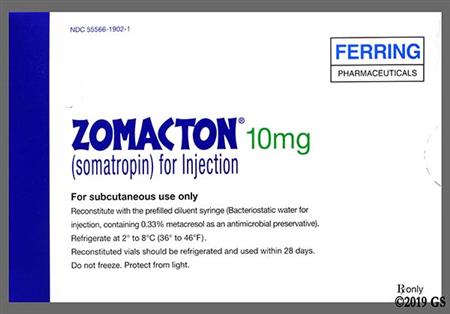
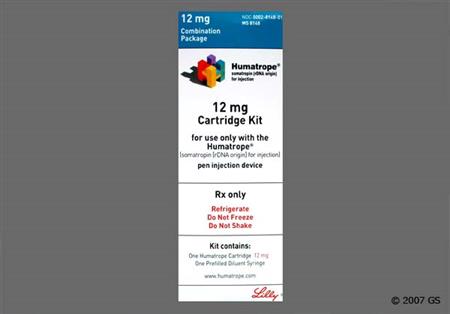
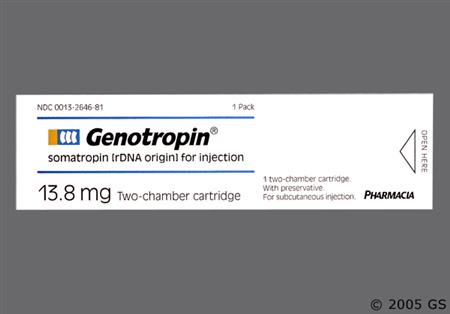
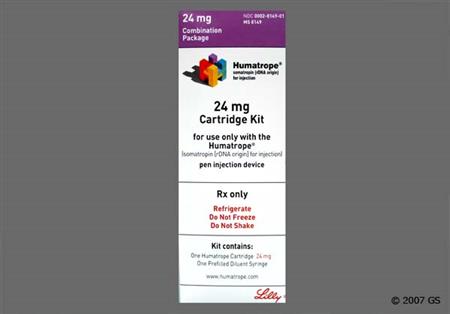
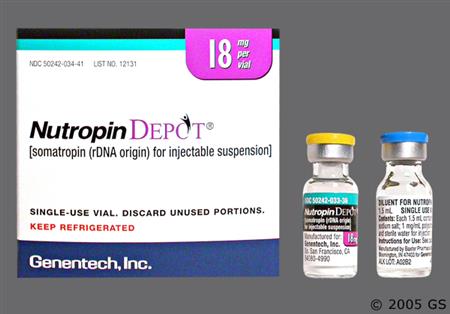
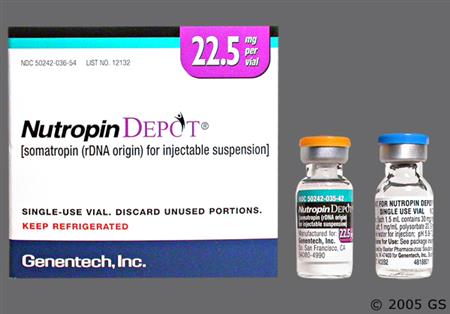
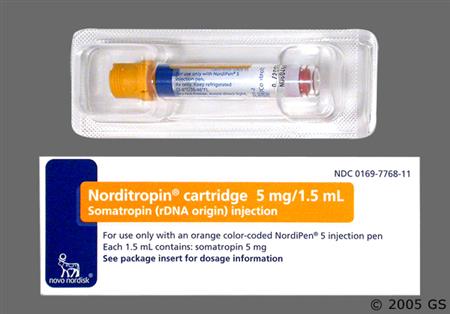


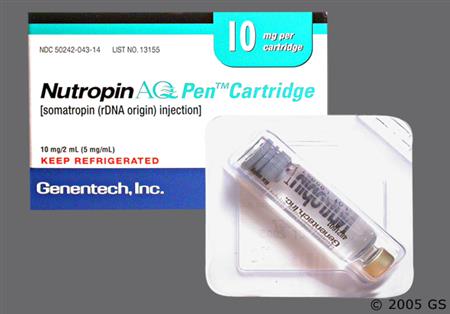
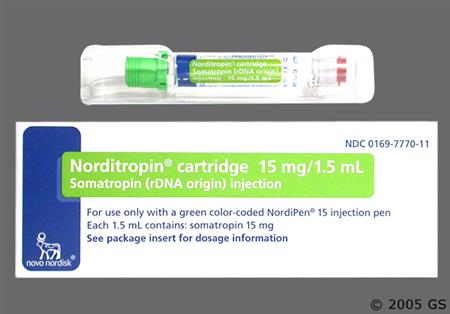
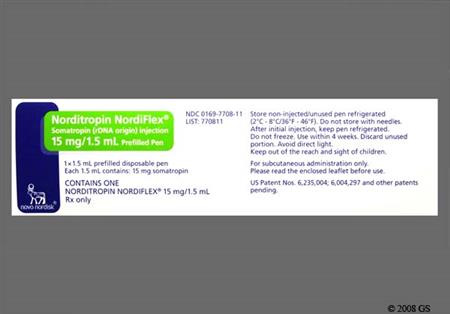
Somatropin, rh-GH is a purified recombinant growth hormone prepared by using either Escherichia coli or mammalian-cells. Endogenous human growth hormone (hGH) is produced in the pituitary gland. Somatropin is approved for treating growth hormone deficiency (GHD), growth failure, or short stature. Several somatropin products are available for growth-related indications, all with varying dosage regimens. Care should be taken in product selection as products may not be considered interchangeable. One product (Serostim) is solely approved for treating cachexia and AIDS wasting in adults. Somatropin (Serostim) has been studied in the treatment of HIV-associated lipodystrophy; limited data indicate use may decrease visceral adipose tissue, but this is still not an FDA-approved use. One product (Zorbtive) was approved to treat adults with short bowel syndrome, but is no longer marketed. Somatropin was originally approved by the FDA in 1987.
For storage information, see the specific product information within the How Supplied section.
Genotropin
Humatrope
Norditropin
Nutropin
Nutropin AQ
Omnitrope
Saizen
Serostim
Zomacton
Somatropin has been associated with an increased risk of a new primary malignancy. Leukemia has been reported in a small number of growth hormone deficient patients treated with somatropin. It is uncertain if this increased risk is related to the pathology of growth hormone deficiency itself, growth hormone therapy, or other associated treatments such as radiation therapy for intracranial tumors. Additionally, in childhood cancer survivors who were treated with radiation to the brain/head for their first neoplasm and who developed subsequent growth hormone deficiency and were treated with somatropin, an increased risk of a new primary malignancy has been reported. Intracranial tumors, in particular meningiomas, were the most common of these second neoplasms. It is unknown whether there is any relationship between somatropin replacement therapy and CNS tumor recurrence in adults. Increases in the size or number of cutaneous nevi were reported during postmarketing surveillance.[58095] Monitor all patients with a history of growth hormone deficiency secondary to an intracranial neoplasm routinely while on somatropin therapy for progression or recurrence of the tumor. Because children with certain rare genetic causes of short stature have an increased risk of developing malignancies, consider the risks and benefits of starting somatropin in these patients. If treatment with somatropin is initiated, these patients should be carefully monitored for development of neoplasms. Monitor patients on somatropin therapy carefully for increased growth, or potential malignant changes, of preexisting nevi. Somatropin therapy should be discontinued if evidence of neoplasia develops.[30059] [56647]
In trials of growth hormone deficient (GHD) adults, rates of edema or peripheral edema have varied according to the brand of somatropin used and ranged from approximately 5% to 45%. In children with GHD, the rates have been approximately 3%. The edema appears to occur early in therapy and may be transient and/or respond to a dose reduction. Both fluid retention and peripheral edema have been commonly reported in patients receiving somatropin. Peripheral edema is more common in adults than children.[33527] [45045] [56647] [56649] [58095] [30059]
Increased intracranial pressure (intracranial hypertension), with papilledema, visual changes, severe head pain, nausea, and vomiting, has been reported in a small number of patients treated with growth hormone products. Symptoms usually occur within the first 8 weeks of treatment initiation. In all reported cases, symptoms resolved after termination of therapy or a reduction in dose. Funduscopic examination of patients is recommended upon initiation of therapy and periodically throughout treatment. If papilledema is observed during treatment, somatropin should be stopped. If intracranial hypertension is diagnosed, the treatment can be restarted at a lower dose. Patients with Turner syndrome may also be at an increased risk for developing intracranial hypertension.[30059]
Joint swelling (5% to 6%), myalgia (3% to 30%), musculoskeletal pain (5% to 14%), pain and stiffness of the extremities (2% to 19%), and back pain (3% to 11%) have been commonly associated with somatropin therapy. Some events are related to fluid retention and appear to occur more frequently in adults than in children, particularly arthralgia (11% to 37%). In adults treated with somatropin, muscle and joint pain usually occurred early in therapy and tended to be transient or respond to dosage reduction. Pain, swelling and/or stiffness may resolve with analgesic use or a reduction in frequency of dosing with somatropin. In addition, carpal tunnel syndrome (nerve entrapment syndrome, 1% to 5%) and arthrosis (8% to 11%), have also been reported. More serious adverse reactions that have been reported include slipped capital femoral epiphysis and progression of scoliosis (4% to 19%) in pediatric patients. Osteonecrosis was reported during postmarketing experience in pediatric patients. Evaluate pediatric patients presenting with a new limp or complaints of hip or knee pain.[30059] [33527] [45044] [45045] [56647] [56649] [58095] [59579]
Metabolic complications have been frequently reported with somatropin therapy. During postmarketing surveillance of various products, there have been cases of new onset glucose intolerance, hyperglycemia, diabetes mellitus, and exacerbation of pre-existing diabetes mellitus.[30059] Some patients developed diabetic ketoacidosis and diabetic coma.[33527] [60682] Discontinuing treatment led to improvement in some patients, while glucose intolerance persisted in others. Monitor glucose concentrations closely during therapy; initiate or adjust antidiabetic treatment as necessary. Short-term overdosage may result in hypoglycemia.[30059] A greater incidence of impaired fasting glucose has been observed with higher doses. During clinical trials, Type 2 diabetes mellitus (DM) was reported in 5% of adults receiving somatropin.[58095] Hypothyroidism has been reported in approximately 5% to 16% of patients receiving somatropin therapy.[45044] [56649] During a 6 month placebo-controlled trial in growth hormone deficient (GHD) adults using the Saizen brand, approximately 10% required small upward adjustments of thyroid hormone replacement therapy for preexisting hypothyroidism, and 1 patient was newly diagnosed with hypothyroidism. Additionally, during the trial, 2 patients required upward adjustments of hydrocortisone maintenance therapy (unrelated to intercurrent stress, surgery, or disease) for preexisting hypoadrenalism, and 1 patient was newly diagnosed with adrenal insufficiency. Monitor thyroid tests periodically and initiate or adjust thyroid replacement therapy as necessary.[56649] Hyperlipidemia (8%) has also been reported, most often as hypertriglyceridemia (1% to 5%).[30059] [33527]
The most common central nervous system (CNS) adverse reactions reported in somatropin clinical trials were in adults and include headache (6—18%), paresthesias (2—17%), and hypoesthesia (2—15%). Asthenia or weakness (3—6%), fatigue (4—9%), insomnia (5%), depression (5%) and dizziness were also reported in trials.[30059] [33527] [45045] [56649] [58095] [60682] Seizures have been reported rarely.[56649]
Upper respiratory tract infection (32%) and fever (16%) have been reported in pediatric patients receiving somatropin.[59579] Naso-pharyngitis (3% to 14%), bronchitis (9%), rhinitis (5% to 14%), and flu like symptoms (4% to 23%) have been reported in somatropin-treated patients during clinical trials.[30059] [45045] [58095] Children with Turner syndrome reported otitis media (16% to 43%) and ear disorders (18%).[30059] Otitis media was reported in 10% of pediatric patients treated with somatropin for short stature due to growth hormone deficiency.[59579] In studies with Norditropin, otitis media and otitis externa were reported more frequently in patients receiving the highest doses.[58095] Increased cough (6% to 9%) has also been reported.[30059] [59579]
Somatropin administration is associated with an injection site reaction (pain or burning associated with injection), lipoatrophy, or nodule formation; lipoatrophy can be avoided by frequent rotation of the injection site. Other injection site reactions include hematoma (9%), fibrosis, erythema, pruritus, rash, swelling, bleeding, and skin hyperpigmentation.[45044] [45045] [56649]
Antibody formation occurs in approximately 2% of patients receiving somatropin. Growth hormone antibody binding capacities below 2 mg/L have not been associated with growth attenuation; however, in some cases when binding capacity exceeds 2 mg/L growth attenuation has been observed. Testing for growth hormone antibodies should be performed in any patient who fails to respond to somatropin therapy.[30059] [45045]
During postmarketing experience with somatropin, dermatologic and serious systemic hypersensitivity reactions including anaphylactoid reactions and angioedema have been reported.[30059] [33527] [45044] [45045] [49770] [56646] [56647] [56649] [58095] [59579] Acne vulgaris (6%), diaphoresis (8%), maculopapular rash (6%), alopecia, and eczema have been reported in patients taking somatropin therapy.[30059] [45045] [58095] [59579] Allergic reactions are possible and include rash; exacerbation of pre-existing psoriasis has also been reported.[56649]
Pancreatitis has been rarely reported in adults and children receiving somatropin, with children, and especially girls with Turner syndrome, appearing to be at greater risk compared to adults. Evaluate any patient who develops abdominal pain for pancreatitis. Other gastrointestinal adverse reactions reported in clinical trials include elevated hepatic enzymes (6% to 13%), abdominal pain (7%), gastritis (6%), gastroenteritis (8%), and diarrhea (5%). An increase in blood alkaline phosphatase concentration and a decrease in serum thyroxin (T4) concentrations have been reported during postmarketing surveillance.[30059] [45045] [58095] [59579]
Gynecomastia has been observed in both adults (3% to 6%) and children (5% to 8%) treated with somatropin in clinical trials. Gynecomastia has also been observed in postmarketing reports.[30059] [33527] [58095]
Hypertension (3% to 8%) and chest pain (unspecified) (5%) have been reported in patients treated with somatropin in clinical trials.[30059] [56649] [58095] Eosinophilia (12%), anemia (6%), and pain (5%) have been reported in pediatric patients receiving somatropin in clinical trials.[45044] [59579] Hematuria has been rarely observed.[45045]
The coadministration of certain medications may lead to harm and require avoidance or therapy modification; review all drug interactions prior to concomitant use of other medications.
This medication is contraindicated in patients with a history of hypersensitivity to it or any of its components.
In 2011, the FDA reviewed the SAGhE (Sante Adulte GH Enfant) study, which suggested a possible 30% increased risk of death in patients treated with somatropin during childhood. However, the evidence was inconclusive due to study limitations. The FDA continues to monitor safety data and recommends that somatropin be used according to the labeled instructions.[45269] A 2016 study devised an advanced mortality model using the Swedish Medical Birth Registry to estimate standardized mortality rates in patients receiving growth hormone compared to the general population. The authors concluded that the increase in mortality found in the SAGhE study was most likely related to basic characteristics of the growth hormone deficiency population (i.e. birth weight, birth length, and congenital malformations) rather than due to the use of growth hormone treatment itself.[61679]
Somatropin therapy may cause changes in some laboratory values. Serum levels of inorganic phosphorus, alkaline phosphatase, and parathyroid hormone may increase with somatropin therapy.
Somatropin is contraindicated in individuals with epiphyseal closure. Slipped capital femoral epiphysis may occur more frequently during periods of rapid growth and can lead to osteonecrosis. Cases of slipped capital femoral epiphysis, with or without osteonecrosis, have been reported in pediatric patients with short stature receiving somatropin. Evaluate pediatric patients presenting with a new limp or complaints of hip or knee pain.[30059] [45044] [45045] [56647] [59579]
Some somatropin multidose vials contain benzyl alcohol as a preservative and should be avoided in neonates. There have been reports of fatal 'gasping syndrome' in neonates (less than 1 month of age) after the administration of parenteral solutions containing the preservative benzyl alcohol at dosages more than 99 mg/kg/day. The minimum amount of benzyl alcohol to cause toxicity is unknown.[45044] [59579]
Somatropin is contraindicated in individuals with active malignancy. Any pre-existing neoplastic disease, specifically intracranial lesions (including pituitary tumors) must be inactive, and chemotherapy and radiation therapy complete, prior to beginning somatropin therapy. In childhood cancer survivors who were treated with radiation to the brain/head for their first neoplasm and who developed subsequent growth hormone deficiency and were treated with somatropin, an increased risk of a new primary malignancy has been reported. Intracranial tumors, in particular meningiomas, were the most common of these second neoplasms. It is unknown whether there is any relationship between somatropin replacement therapy and CNS tumor recurrence in adults. Monitor all individuals with a history of growth hormone deficiency secondary to an intracranial neoplasm routinely while on somatropin therapy for progression or recurrence of the tumor. Because children with certain rare genetic causes of short stature have an increased risk for cancer, consider the risks and benefits of starting somatropin in these individuals. If treatment with somatropin is initiated, these individuals should be carefully monitored for development of neoplasms. Monitor individuals on somatropin therapy carefully for increased growth, or potential malignant changes, of preexisting nevi. Somatropin therapy should be discontinued if evidence of neoplasia develops.[30059] [45044] [45045] [56647] [59579]
Somatropin is contraindicated in patients with acute critical illness due to complications following open heart or abdominal surgery, multiple accidental trauma or to patients having acute respiratory failure. Two placebo-controlled clinical trials in non-growth hormone deficient adult patients (n = 522) with these conditions revealed a significant increase in mortality (41.9% vs. 19.3%) among somatropin-treated patients (5.3 to 8 mg/day) compared to those receiving placebo. The safety of continuing somatropin treatment in patients receiving replacement doses for approved indications who currently develop these illnesses has not been established. Therefore, the potential benefit of treatment continuation with somatropin in patients having acute critical illnesses should be weighed against the potential risk.[30059] [45044] [45045] [56647] [59579]
Somatropin is contraindicated in individuals with Prader-Willi syndrome who are severely obese or have severe respiratory impairment. Unless individuals with Prader-Willi syndrome also have a diagnosis of growth hormone deficiency, somatotropin is not indicated for long-term treatment of pediatric patients who have growth failure due to genetically confirmed Prader-Willi syndrome. There have been reports of fatalities with the use of growth hormone in pediatric patients with Prader-Willi syndrome who had one or more of the following risk factors: severe obesity, history of respiratory insufficiency or sleep apnea, or unidentified respiratory infection. Male individuals with one or more of these factors may be at increased risk. Individuals with Prader-Willi syndrome should be evaluated for upper airway obstruction before initiation of treatment with growth hormone. If during treatment with growth hormone, individuals show signs of upper airway obstruction (including onset of or increased snoring), treatment should be interrupted. All individuals with Prader-Willi syndrome should be evaluated for obstructive sleep apnea and monitored if sleep apnea is suspected. All individuals with Prader-Willi syndrome should also have effective weight control and be monitored for signs of respiratory infections, which should be diagnosed as early as possible and treated aggressively. Individuals with Prader-Willi syndrome may also be at increased risk of intracranial hypertension.[30059] [45044] [45045] [56647] [59579]
Somatropin should be used cautiously in individuals with diabetes mellitus. Individuals with diabetes or glucose intolerance and those individuals with risk factors for diabetes or glucose intolerance should be monitored closely during treatment with somatropin. Risk factors for glucose intolerance include obesity (including obese individuals with Prader-Willi Syndrome), Turner syndrome, or a family history of type II diabetes. Because somatropin may reduce insulin sensitivity, especially at higher doses, individuals should be monitored for evidence of glucose intolerance. Glucose intolerance or acromegaly may occur with chronic overdosage of somatropin. Dose adjustments of antidiabetic medications may be necessary when somatropin is initiated. Due to the effects of somatropin on insulin sensitivity and blood glucose concentrations, somatropin is contraindicated in individuals with proliferative diabetic retinopathy and severe non-proliferative diabetic retinopathy.[30059] [45044] [45045] [56647] [59579]
Individuals with a history of scoliosis should receive somatropin with caution. Because growth hormone increases growth rate, individuals with scoliosis can experience progression of scoliosis. Individuals should be monitored for progression of scoliosis. In addition, skeletal abnormalities including scoliosis are commonly seen in untreated Turner's syndrome, Noonan's syndrome, and individuals with Prader-Willi syndrome. Clinicians should be aware of these abnormalities which may manifest during growth hormone therapy.[30059] [45044] [45045] [56647] [59579]
No adequate and well controlled studies have been conducted in pregnant humans, and the potential for somatropin to cause adverse effects on the fetus or reproductive system is unknown. In animal studies that have been performed, differing doses exceeding the regular human dose revealed no evidence of impaired fertility or harm to the fetus. Inform females of childbearing age that use of somatropin during pregnancy has not been studied in humans, therefore, the effects of the drug on the fetus are unknown.[30059] [33527] [45044] [45045] [60682]
Individuals who have or at risk for pituitary insufficiency, and are receiving somatropin, may be at risk for reduced serum cortisol levels and/or unmasking of central (secondary) adrenal insufficiency. Individuals treated with glucocorticoid replacement for previously diagnosed adrenal insufficiency may require an increase in their maintenance or stress doses following initiation of somatropin treatment. In addition, individuals with untreated hypothyroidism will have an inadequate response to somatropin therapy. Changes in thyroid hormone plasma levels may develop during somatropin therapy because individuals with Turner's syndrome have an inherent risk of developing autoimmune thyroid disease. Periodic thyroid function tests should be performed and treatment with thyroid hormone initiated when indicated.[30059] [45044] [45045] [56647] [59579]
No data are available regarding the presence of somatropin in human milk, the effects of somatropin on the breast-fed infant, or the effects of somatropin on milk production. Limited published literature reports no adverse effects on breast-feeding infants with maternal administration of somatropin and no decrease in milk production or change in milk content during treatment with somatropin. Consider the benefits of breast-feeding, the risk of potential infant drug exposure, and the risk of an untreated or inadequately treated condition. If a breast-feeding infant experiences an adverse effect related to a maternally administered drug, healthcare providers are encouraged to report the adverse effect to the FDA.[30059] [33527] [45044] [45045] [60682]
Clinical studies of somatropin did not include sufficient numbers of geriatric subjects, and clinical experience has not identified different responses between geriatric and younger adults. Dose selection for older individuals should be cautious, usually starting at the low end of the dosing range. Geriatric individuals are more at risk for the adverse effects of therapy. Growth hormone/somatropin should only be prescribed to individuals with clinical features suggestive of adult growth hormone deficiency (GHD) and biochemically proven evidence of adult GHD. There are no data available to suggest that somatropin has beneficial effects in treating aging and age-related conditions and the enhancement of sporting performance; therefore, non-approved uses of the drug are not recommended.[60946] According to the Beers Criteria, growth hormone is considered a potentially inappropriate medication in geriatric individuals.[30059] [45044] [45045] [56647] [59579] [63923]
Endogenous growth hormone is responsible for stimulating normal skeletal, connective tissue, muscle, and organ growth in children and adolescents. It also plays an important role in adult metabolism. Recombinant products mimic all of these actions. Somatropin binds to growth hormone (GH) receptors and produces a variety of physiologic effects that can be classified as being direct or indirect. The direct effects include antagonism of the peripheral action of insulin and the subsequent stimulation of insulin secretion; stimulation of the production of somatomedins or insulin-like growth factors (IGFs) in the liver and other tissues; stimulation of triglyceride hydrolysis in adipose tissue; stimulation of hepatic glucose output; induction of a positive calcium balance; and retention of sodium and potassium. These effects oppose the action of insulin on fat and carbohydrate metabolism and are potentiated by glucocorticoids.[56647][57484]
Somatomedins or insulin-like growth factors (IGFs) indirectly mediate the anabolic and growth-promoting effects of somatropin. IGFs circulate throughout the body and bind to specific IGF receptors. Two IGFs have been identified, IGF-1 and IGF-2. IGF-1 appears to be the principal mediator of the action of growth hormone, whereas IGF-2 has more insulin-like activity. The principal anabolic actions of IGFs include stimulation of amino acid transport, stimulation of DNA, RNA, and protein synthesis, and induction of cell proliferation and growth. IGF-1 is directly responsible for chondrogenesis, skeletal growth, and the growth of soft tissue. Linear growth is stimulated by affecting cartilaginous growth areas of long bones. Growth is also stimulated by increasing the number and size of skeletal muscle cells, influencing the size of organs, and increasing red cell mass through erythropoietin stimulation. The actions of growth hormone on the gut may be direct or mediated via the local or systemic production of IGF. In-vivo studies have shown that growth hormone enhances transmucosal transport of water, electrolytes, and nutrients. These indirect effects are inhibited by glucocorticoids.[57484]
Revision Date: 09/14/2025, 02:11:43 PMSomatropin is administered by intramuscular or subcutaneous injection. Peak plasma concentrations of somatropin are reached in 2—6 hours following administration. About 20% of the circulating somatropin is bound to growth hormone-binding protein. Peak plasma concentrations of IGF-1 occur about 20 hours after administration of somatropin. Somatropin is metabolized by the liver, kidney, and other tissues. Somatropin undergoes glomerular filtration and the molecule is cleaved in the kidney. Once cleavages occurs in the renal cells, the peptides and amino acids are returned to the systemic circulation. Little excretion occurs via the urine. The plasma elimination half-life is approximately 20—30 minutes. Because of continued release of somatropin from the intramuscular or subcutaneous site, serum concentrations decline with a half-life of about 3—5 hours. Because of the slow induction and clearance of IGF-1, the effects of somatropin last much longer than its elimination half-life.
Following subcutaneous injection of the depot formulation, somatropin is released from the microspheres initially by diffusion, followed by both polymer degradation and diffusion. The estimated bioavailability following a single dose of Nutropin Depot ranges from 33—38% when compared to single dose Nutropin AQ and from 48—55% when compared to chronically dosed Protropin. Once released and absorbed, somatropin is believed to distributed and eliminated in a manner similar to somatropin formulated for daily administration. Both the Cmax and AUC are proportional to the dose. Serum growth hormone levels > 1 mcg/l persist for approximately 11—14 days following single doses of 0.75 or 1.5 mg/kg.
It appears that the clearance of somatropin in children and adults is similar; however, no pharmacokinetic studies have been conducted in children with short bowel syndrome.
Biomedical literature indicates males may clear somatropin more quickly than females, although no gender-based analysis is available.
No adequate and well controlled studies have been conducted in pregnant humans, and the potential for somatropin to cause adverse effects on the fetus or reproductive system is unknown. In animal studies that have been performed, differing doses exceeding the regular human dose revealed no evidence of impaired fertility or harm to the fetus. Inform females of childbearing age that use of somatropin during pregnancy has not been studied in humans, therefore, the effects of the drug on the fetus are unknown.[30059] [33527] [45044] [45045] [60682]
No data are available regarding the presence of somatropin in human milk, the effects of somatropin on the breast-fed infant, or the effects of somatropin on milk production. Limited published literature reports no adverse effects on breast-feeding infants with maternal administration of somatropin and no decrease in milk production or change in milk content during treatment with somatropin. Consider the benefits of breast-feeding, the risk of potential infant drug exposure, and the risk of an untreated or inadequately treated condition. If a breast-feeding infant experiences an adverse effect related to a maternally administered drug, healthcare providers are encouraged to report the adverse effect to the FDA.[30059] [33527] [45044] [45045] [60682]
Cookies are used by this site. To decline or learn more, visit our cookie notice.
Copyright © 2025 Elsevier, its licensors, and contributors. All rights are reserved, including those for text and data mining, AI training, and similar technologies.